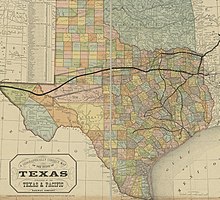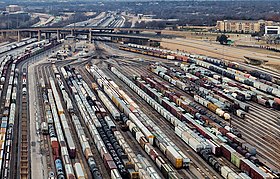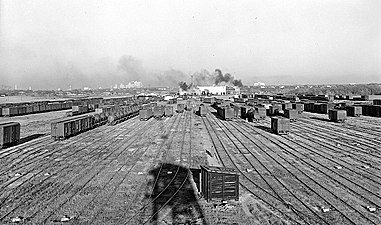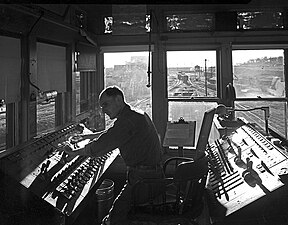Davidson Yard
| Davidson Yard | |
|---|---|
|
Directional Harp (43 tracks) at Davidson Yard, 2017 |
|
| Data | |
| Operating point type | Marshalling yard |
| Design | Through station |
| opening | 1928 |
| location | |
| Place / district | Fort Worth |
| State | Texas |
| Country | United States |
| Coordinates | 32 ° 43 '33 " N , 97 ° 22' 20" W |
| List of train stations in the United States | |
The Davidson Yard is a marshalling yard of the Union Pacific Railroad (UP) in Fort Worth , Texas . It is located about five kilometers southwest of the city center and extends over five kilometers to the southwest. Built in 1923 as Lancaster Yard by the Texas and Pacific Railway (T&P), it has been modernized and expanded several times in its almost 100-year existence. Through several takeovers and mergers, it was part of the Missouri Pacific Railroad (MP) from 1976 and has been in the possession of the UP since the end of the 20th century, which it is today in the greater Dallas-Fort Worth-Arlington area as part of one of the most important railway junctions between the North - operates south and east-west connections in freight traffic. The marshalling yard has been named after the former UP President Richard K. Davidson since 2007 .
history

The Texas and Pacific Railway (T&P), founded in 1871, built a route network through central Texas from Marshall in the east to Sierra Blanca in the west until the beginning of the 1880s , where the originally planned expansion to the Pacific coast finally connected to the network of the Southern Pacific Railroad was replaced. In Fort Worth, one of the most important railway junctions developed between the east-west connection of the T&P and the north-south connections of other railway companies. In 1926, T&P acquired an area of around 243 hectares southwest of the city center in Fort Worth and built a modern marshalling yard with a large roundhouse here by 1928 . On a track length of around 100 km, 645 employees were able to shunt 3,000 freight wagons per day in continuous shifts and maintain 70 steam locomotives . The construction of the Lancaster Yard cost around 5 million US dollars , named after the President of T&P John L. Lancaster.
In the 1930s, T&P continued to invest in its infrastructure in Fort Worth and built two large Art Deco- style buildings along the route leading to the city center, the Terminal Warehouse and the T&P Station , which served as a freight depot and warehouse or passenger depot and office building . The capacity of the upstream Lancaster Yard was increased to 5,000 freight wagons a day until the 1940s. With the increase in motorized individual traffic and the shift of goods transport to the road, at the end of the 1960s, passenger traffic and later the use of the buildings were completely stopped. The Missouri Pacific Railroad (MP) as the main shareholder of T&P modernized the marshalling yard from the 1960s onwards, which was renamed Centennial Yard in 1971 for the centenary of T&P . By 1976, T&P was finally absorbed by MP, which was acquired by the Union Pacific Railroad (UP) in the early 1980s and, like the Southern Pacific, was fully integrated into today's UP network by the end of the 20th century. The UP modernized the marshalling yard again and renamed it Davidson Yard in 2007 in honor of the former president of the railway company Richard K. Davidson , who had worked here for the MP at the beginning of his career in the 1960s and 1970s .
Lancaster Yard on the Texas and Pacific Railway 1946
Today's plant
The UP flat station now extends over an area of 156 hectares with a total track length of around 80 km. It is divided into an entry group with eight tracks, a directional harp consisting of 43 tracks and an exit group with twelve tracks. In addition, there are five transfer tracks for bypassing the marshalling yard as well as maintenance halls with several access tracks for diesel locomotives and freight cars on the east side. The drainage hill and the six-story signal box are located on the west side of the marshalling yard. Every day around 1,800 freight wagons are shunted and 20 trains put together that can reach lengths of over three kilometers. The annual volume handled is 500,000 freight wagons.
See also
Web links
- Davidson Yard (Lancaster Yard), Fort Worth, Texas, 1923. SMU Libraries / DeGolyer Library.
- Union Pacific Railroad's New Davidson Yard Track Advances Progress on Southwest Parkway. UP News Release, March 10, 2009. Retrieved April 22, 2019.
Individual evidence
- ↑ Mike Nichols: John L. Lancaster's Full-Scale Train Set. Hometown by Handlebar, accessed April 22, 2019.
- ^ From Ox-teams to Eagles: A History of the Texas and Pacific Railway. Texas & Pacific Railway, Dallas 1946 ( online ).
- ^ Maury Klein : Union Pacific: The Reconfiguration . America's Greatest Railroad from 1969 to the Present. Oxford University Press, 2011, ISBN 978-0-19-536989-2 , pp. 161 f .
- ^ Bill J. Wright, Steve R. Waits: Evolution of The Davidson Yard. In: Fiber Optic Focus. Union Pacific Railroad, Vol. 26, No. 1, February 2011, Insert.
- ↑ Peter Gorman: Trains Rolled On. Fort Worth Weekly, June 10, 2015. Retrieved April 22, 2019.
- ↑ Michael Rhodes: North American Railyards. Arcadia Publishing, 2003, ISBN 0-7603-1578-7 , p. 82.







